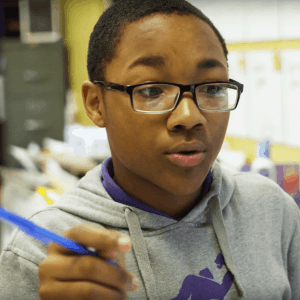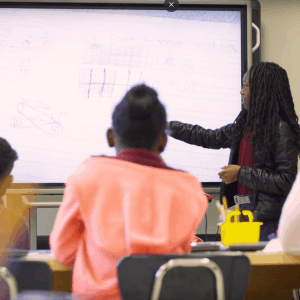
Math: Do You Love it or Hate it?
03/30/2023

How our experiences with math shape the ways we see ourselves
 The mere mention of math often brings out strong emotions in people. Either you love it, or you hate it. Those personal feelings you bring to math usually have something to do with how you were taught and the expectations your teachers set throughout school.
The mere mention of math often brings out strong emotions in people. Either you love it, or you hate it. Those personal feelings you bring to math usually have something to do with how you were taught and the expectations your teachers set throughout school.
But what if there’s a third option? What if there’s a way to look at math through a lens of curiosity? Instead of math being about black and white concepts, seeing and embracing the shades of gray that inevitably surround any problem that needs to be solved? I spoke with Rachel Scarpato, Senior Director of Math Strategy at Leading Educators, about her math experience and how feelings of belonging shape students’ opportunities to become confident mathematicians. It has been lightly edited for clarity and brevity.
Am I a Math Person?
Laura Troxel: There are a lot of thoughts and feelings around the subject of math and some very strong beliefs about who is a “math person.” As a math educator, what are some of the misconceptions that people have about math education?
Rachel Scarpato: I think the first one that comes to mind, and I’m sure you’ve heard this, is that some people are born math people. And those people tend to be white and tend to be male. If you think of who comes to mind when you think of a mathematician, it’s probably an old white Greek person.
This binary—I’m either good at math or bad at math—brings people to believe certain things about themselves. At the end of the day, it becomes a mindset you have about yourself as a learner, and that impacts how you show up in the world.
When someone says, “Math was really hard for me, and I don’t consider myself a math person,” that’s communicating that they probably didn’t feel like they belonged in those spaces. Peeling back all the layers, I think it’s an issue of belonging. I do the work that I do because I want more people—more students, more teachers, and specifically folks with marginalized identities—to feel that math, as a domain of learning or as a field, is a place where they belong. They can be themselves and use what they know and their experiences as assets in their mathematical thinking.
math takes practice
LT: You talk about belonging and how important that is. I know in your math journey, there was a sense as you got older where that feeling of belonging wasn’t there, despite being on an advanced track. Can you tell me a little bit about what that journey was like for you?
RS: Some of the earliest memories that I have of math and math class started in fourth grade, which was, interestingly, the grade that I primarily taught. But I remember that was the year where we broke out into groups just for math. So, for most of the day, I was with my class, but then for math, there were groups and kids mixed in from all the other classes. While it wasn’t stated by the teachers, everyone knew that these were ability-based groups, even at 9 years old. The kids deemed “good at math” were in one space, and the kids perceived to be “struggling” were in a different space. I remember knowing that, and at that point, I was in the higher-ability group. The school I attended was predominantly white, but only a handful of girls were in that group, so I was in class with mostly boys.
LT: How did you feel about those classes as an elementary student, and what changed as you entered high school?
RS: I’m sure a lot of people can relate to what class involved, which was a lot of timed drills. When the timer went off and it was beeping, it would make me really anxious because I was like, “I gotta finish this sheet!” I think my identity started out as “I’m a more advanced math learner.” But math was never a class that I enjoyed; I would say it was more, “Alright, I’m in school, and I want to do well, and this is just what I have to do.”
In high school, I switched schools and went to a private school. That was when I realized my math skills and where I was at weren’t cutting it. I remember taking AP Calculus, and in class the first day, I had never experienced this feeling. I was like, “What is going on right now? Everyone is talking about something and I don’t understand. I’m not in on this new sort of language.”
A misconception that I had about math at the time, and that continues to prevail in society, is that math is supposed to come easy to you and it’s supposed to come quickly. That was not the case for me in this situation. I was also a perfectionist, concerned about my GPA and college, so I just dropped the class and I took a regular-level calculus class that was taught more like memorization, which felt comfortable.
everyone needs to feel like they belong
LT: It’s interesting this feeling of belonging in a class because I had a similar situation where I advanced a math grade in high school, but I would not consider myself a math person at all. I liked algebra because it made sense to me, but I didn’t like geometry because my teacher would tell me, “Well, you got the right answer, but you didn’t follow the exact proof, so it’s wrong.” And I always thought, “Why does it matter how I get from point A to point C? Shouldn’t it be right if I skip B but still get the right answer?” But he was very much of the mindset that it must be done a certain way or it’s wrong. I struggled in geometry, and like you, I was a perfectionist. I was very concerned about my GPA and getting into college.
When I wanted to take trig my junior year, I wanted to audit it because this same teacher was teaching that class too. I remember very distinctly him telling me, “I won’t let you audit it, but I think you could probably get a C in this class.” And I remember thinking, “I’m on track to be either the valedictorian or the salutatorian in my class. Why in the world would I take a class that I know is going to lower my GPA?”
Even 25 years later, I will never forget that. And I never took another math class in high school. When I got to college, I had to take remedial math my first semester, but it wasn’t that I couldn’t do math or wasn’t smart enough. It was just that experience in the classroom that turned me off. I just thought math was not my thing.
RS: So you were told that you’re solving problems wrong if you take trig, you’ll get a C, and then have to take remedial math in college. Just those three things alone send clear messages to you about your space in math and your career trajectory in a math-related field.
If you’re tracked, students are, unfortunately, getting those messages every single day about their belonging in math and their future, and it’s just not okay. It has consequences. Certain classes are what researchers call “gatekeepers.” If students can’t pass the classes, there’s a correlation with their likelihood of graduating high school and college.
But at the same time, math can open doors for people. We know that STEM fields are very high paying. Interesting things are happening in the world in STEM and STEM spaces. So, there’s both this keeping out, and for the select few that do get through, there’s a wide range of opportunities for them. So, how do we open that door for more students?
Making Math Make Sense
LT: Once you started teaching, how did that change your perception of math and how math should be taught? Did you look at your past experiences and make adjustments in your teaching techniques based on those experiences?
RS: When I first started teaching, which was pre-Common Core standards, I was fortunate to have a math coach at my school who was really forward-thinking and interested in how math was taught. She wanted to give students a different experience than probably most of us teachers had. I remember sitting with her and her showing me different strategies for solving addition and subtraction problems. The traditional method, and the one we were both probably taught, is to line the digits up by their place value and calculate.
 But then she showed a number line where if you’re wanting to subtract values, you can think of, you’re starting at this point on the number line and then going back on the number line, and you get to decide how big the jumps are. You’re not being subscribed to a certain way of doing this. There’s some creativity and flexibility.
But then she showed a number line where if you’re wanting to subtract values, you can think of, you’re starting at this point on the number line and then going back on the number line, and you get to decide how big the jumps are. You’re not being subscribed to a certain way of doing this. There’s some creativity and flexibility.
For example, subtracting a number like 56, you could subtract by 10s. You could be like, minus 10, minus 10, minus 10, etc., or you could start by taking one bigger jump backward of 50. It gave a more visual way of understanding what is actually happening with addition and subtraction and gave flexibility for problem-solving. I realized this was different from how I learned, and opened my eyes to how I could teach math.
One thing I remember growing up was I was taught mean, median, and mode every year for maybe four years straight. It always felt super disconnected from anything I was learning or anything in the real world. It was just a set of numbers. And I realized, as I was teaching, that there are rich opportunities to make connections in the classroom to real-world things.
applying math to the real world
LT: I think that’s a crucial point. There was no connection when I was taught math and you were taught math. During COVID, my niece was doing pre-algebra and we were working with percentages. I explained to her how this is something you’re going to use because when you go to a store and see a sale, you want to know how much money you’ll save on an item. And for her, suddenly, that made sense because she’s very frugal and likes to save money. I think that as some of these higher quality curriculums come in and there’s more emphasis on real-life application, the students in the class feel a little more connected to what they are learning and why.
RS: This idea that “none of this is useful in my life, and I just need to get through it” is another common misconception about math. What I think is the game changer is the process of how math is taught and how a student approaches solving a problem. That is the transferable thing that needs to be of greater focus.
For example, what did you do when you weren’t sure how to start this problem? Did you reference things that you knew? Did you think about what was unknown in the problem? Or did you talk to a classmate? Did you talk to a friend? What did you do to get started? Okay, how can you use this in life?
This is a very small example, but this idea of problem-solving and reasoning is typically not focused on when we talk about math and its application to real life. Because most math classrooms currently are not focused on reasoning and thinking about problem-solving more deeply, there’s so much potential there. When you have a problem, and you don’t know what to do, and you’re trying to find access points, you’re trying to collaborate with others to get folks to bring their ideas to the table of how we solve this. And that’s sometimes beyond the actual subject matter. Math class should get students thinking about problems and help them see that math is a tool they could use to solve the problems that they face or that their community faces.
Math is a Team Sport
LT: Somewhere along the line, that critical thinking aspect of it seems to get lost in translation, and that’s really what you want them to learn. Regardless of whether or not they get the correct answer, as long as they’re thinking through the problem and thinking critically about it, they are learning something. I can’t even imagine what it would be like to be in a math classroom with students where you have collaboration as you’re trying to solve problems. That’s mind-blowing to me. But when I see evidence in classrooms of how teachers are facilitating that way, it looks so much more fun. And kids are getting a lot more out of that class.
RS: At one professional learning session I facilitated, I said, “Math is not an individual sport. Math is a team sport.” And as much as we can recognize and embrace that, I think kids will benefit so much more.
Stay tuned!
In part 2 of this story, Rachel talks about bringing equity into a math class and overcoming math anxiety.







